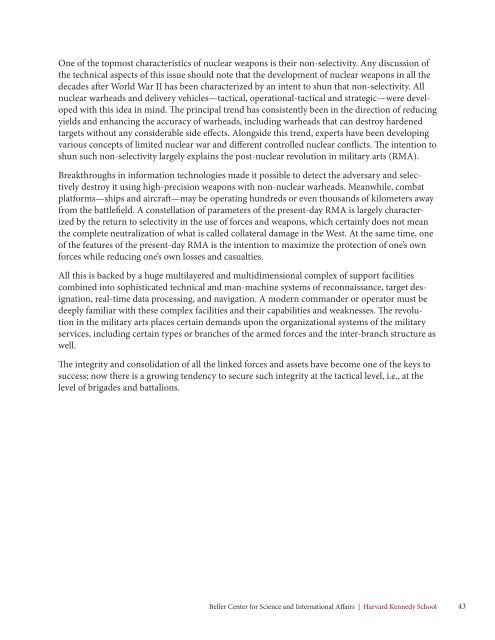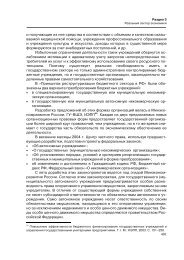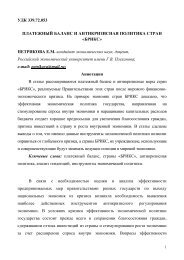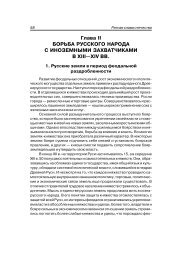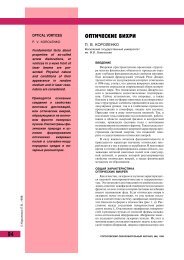Mobility, <strong>in</strong> comb<strong>in</strong>ation with <strong>the</strong> uniform data field, <strong>and</strong> <strong>the</strong> relevant operational <strong>and</strong> combattra<strong>in</strong><strong>in</strong>g <strong>and</strong> equipment of soldiers <strong>and</strong> battle groups, makes it possible to conduct multifocalcombat operations <strong>in</strong> dispersed battle arrays <strong>and</strong> thus defocus <strong>the</strong> adversary’s attention. All typesof mobility are extremely important for Russia, with its immense territory <strong>and</strong> various conditionsfor fulfillment of <strong>the</strong> military mission <strong>and</strong> conduct of combat operations by <strong>the</strong> armed forces. Unfortunately,this importance is not adequately perceived even by <strong>the</strong> Russian expert community.In a present-day war, with multifocal combat operations <strong>and</strong> no solid front l<strong>in</strong>es, we are notic<strong>in</strong>gan <strong>in</strong>crease <strong>in</strong> <strong>the</strong> share of special assets <strong>and</strong> forces, which take over a number of tasks that usedto be <strong>in</strong>tr<strong>in</strong>sic to <strong>the</strong> ground forces.In <strong>the</strong> context of <strong>the</strong> qualitatively new stage of development of aerospace assault weapons, whichpotentially may be used aga<strong>in</strong>st Russia, it becomes especially important to develop new approachestoward <strong>the</strong> assets <strong>and</strong> systems of air defense, missile defense <strong>and</strong> space defense at all levels(strategic, operational <strong>and</strong> tactical), <strong>and</strong> to set realistic tasks for <strong>the</strong>se systems with due regardfor particular <strong>the</strong>aters, types of military operations, <strong>and</strong> various scenarios of aggravation of <strong>the</strong>political-military situation. Aga<strong>in</strong>, <strong>the</strong> role of electronic warfare <strong>in</strong> this context should becomemore <strong>and</strong> more important. 82In <strong>the</strong> past, <strong>the</strong> strategic air defense forces <strong>and</strong>, to a lesser extent, <strong>the</strong> space <strong>and</strong> missile defenseforces that were extensively developed <strong>in</strong> <strong>the</strong> Soviet Union were predom<strong>in</strong>antly stationary, <strong>and</strong><strong>the</strong>ir mobility capabilities were m<strong>in</strong>imal. Today, Russia needs to develop <strong>the</strong>se forces by focus<strong>in</strong>gon <strong>the</strong>ir mobility—not just tactically, but <strong>in</strong> <strong>the</strong> operational <strong>and</strong> strategic spheres as well. Thenew tactical <strong>and</strong> technical requirements <strong>and</strong> tasks concern<strong>in</strong>g <strong>the</strong> development of new components<strong>and</strong> <strong>the</strong> modernization of exist<strong>in</strong>g ones must be formulated with this goal <strong>in</strong> m<strong>in</strong>d. In thiscontext, <strong>the</strong> means of mobility, which <strong>in</strong> particular provide for <strong>the</strong> quick long-distance deliveryof air-defense missile systems (ADMS), <strong>and</strong> also <strong>in</strong>clude heavy cargo aircraft like <strong>the</strong> An-124 <strong>and</strong><strong>the</strong> relevant airfield <strong>and</strong> <strong>in</strong>formation <strong>in</strong>frastructure, will become <strong>in</strong>creas<strong>in</strong>gly important.In all, it is necessary to state that <strong>in</strong> <strong>the</strong> modern context, <strong>the</strong> parameters of evaluation of <strong>the</strong> balanceof forces <strong>and</strong> <strong>the</strong> conditions of strategic stability of general-purpose forces have becomemore complex, multidimensional <strong>and</strong> multivariate. Today, evaluations of <strong>the</strong> actual combatstrength of <strong>the</strong> sides, of <strong>the</strong> balance of forces, <strong>and</strong> of <strong>the</strong> conditions for secur<strong>in</strong>g strategic stability,should be based to an even lesser extent on calculations of <strong>the</strong> number of strike aircraft, tanks,armored combat vehicles (ACV), artillery pieces <strong>and</strong> helicopters than was <strong>the</strong> case <strong>in</strong> <strong>the</strong> recentpast.However, as was <strong>the</strong> case dur<strong>in</strong>g previous revolutions <strong>in</strong> <strong>the</strong> military arts, all <strong>the</strong> latest militaryhardware can be found alongside traditional, prerevolutionary hardware, albeit of <strong>the</strong> more technologicallyadvanced variety, such as tanks, o<strong>the</strong>r ACVs, aircraft carriers <strong>and</strong> additional systems.Some combat platforms are used <strong>in</strong> a new way. Certa<strong>in</strong>ly, all <strong>the</strong>se aspects should be reflected <strong>in</strong><strong>the</strong> new provisions of <strong>the</strong> military doctr<strong>in</strong>e of <strong>the</strong> Russian Federation, set down <strong>in</strong> its field manuals<strong>and</strong> <strong>in</strong>structions, <strong>and</strong> clarified <strong>in</strong> Russia’s programs <strong>and</strong> plans of development of weaponry <strong>and</strong>military hardware.42<strong>Ensur<strong>in</strong>g</strong> <strong>Strategic</strong> <strong>Stability</strong> <strong>in</strong> <strong>the</strong> <strong>Past</strong> <strong>and</strong> <strong>Present</strong>: Theoretical <strong>and</strong> Applied Questions
One of <strong>the</strong> topmost characteristics of nuclear weapons is <strong>the</strong>ir non-selectivity. Any discussion of<strong>the</strong> technical aspects of this issue should note that <strong>the</strong> development of nuclear weapons <strong>in</strong> all <strong>the</strong>decades after World War II has been characterized by an <strong>in</strong>tent to shun that non-selectivity. Allnuclear warheads <strong>and</strong> delivery vehicles—tactical, operational-tactical <strong>and</strong> strategic—were developedwith this idea <strong>in</strong> m<strong>in</strong>d. The pr<strong>in</strong>cipal trend has consistently been <strong>in</strong> <strong>the</strong> direction of reduc<strong>in</strong>gyields <strong>and</strong> enhanc<strong>in</strong>g <strong>the</strong> accuracy of warheads, <strong>in</strong>clud<strong>in</strong>g warheads that can destroy hardenedtargets without any considerable side effects. Alongside this trend, experts have been develop<strong>in</strong>gvarious concepts of limited nuclear war <strong>and</strong> different controlled nuclear conflicts. The <strong>in</strong>tention toshun such non-selectivity largely expla<strong>in</strong>s <strong>the</strong> post-nuclear revolution <strong>in</strong> military arts (RMA).Breakthroughs <strong>in</strong> <strong>in</strong>formation technologies made it possible to detect <strong>the</strong> adversary <strong>and</strong> selectivelydestroy it us<strong>in</strong>g high-precision weapons with non-nuclear warheads. Meanwhile, combatplatforms—ships <strong>and</strong> aircraft—may be operat<strong>in</strong>g hundreds or even thous<strong>and</strong>s of kilometers awayfrom <strong>the</strong> battlefield. A constellation of parameters of <strong>the</strong> present-day RMA is largely characterizedby <strong>the</strong> return to selectivity <strong>in</strong> <strong>the</strong> use of forces <strong>and</strong> weapons, which certa<strong>in</strong>ly does not mean<strong>the</strong> complete neutralization of what is called collateral damage <strong>in</strong> <strong>the</strong> West. At <strong>the</strong> same time, oneof <strong>the</strong> features of <strong>the</strong> present-day RMA is <strong>the</strong> <strong>in</strong>tention to maximize <strong>the</strong> protection of one’s ownforces while reduc<strong>in</strong>g one’s own losses <strong>and</strong> casualties.All this is backed by a huge multilayered <strong>and</strong> multidimensional complex of support facilitiescomb<strong>in</strong>ed <strong>in</strong>to sophisticated technical <strong>and</strong> man-mach<strong>in</strong>e systems of reconnaissance, target designation,real-time data process<strong>in</strong>g, <strong>and</strong> navigation. A modern comm<strong>and</strong>er or operator must bedeeply familiar with <strong>the</strong>se complex facilities <strong>and</strong> <strong>the</strong>ir capabilities <strong>and</strong> weaknesses. The revolution<strong>in</strong> <strong>the</strong> military arts places certa<strong>in</strong> dem<strong>and</strong>s upon <strong>the</strong> organizational systems of <strong>the</strong> militaryservices, <strong>in</strong>clud<strong>in</strong>g certa<strong>in</strong> types or branches of <strong>the</strong> armed forces <strong>and</strong> <strong>the</strong> <strong>in</strong>ter-branch structure aswell.The <strong>in</strong>tegrity <strong>and</strong> consolidation of all <strong>the</strong> l<strong>in</strong>ked forces <strong>and</strong> assets have become one of <strong>the</strong> keys tosuccess; now <strong>the</strong>re is a grow<strong>in</strong>g tendency to secure such <strong>in</strong>tegrity at <strong>the</strong> tactical level, i.e., at <strong>the</strong>level of brigades <strong>and</strong> battalions.Belfer Center for Science <strong>and</strong> International Affairs | Harvard Kennedy School 43


